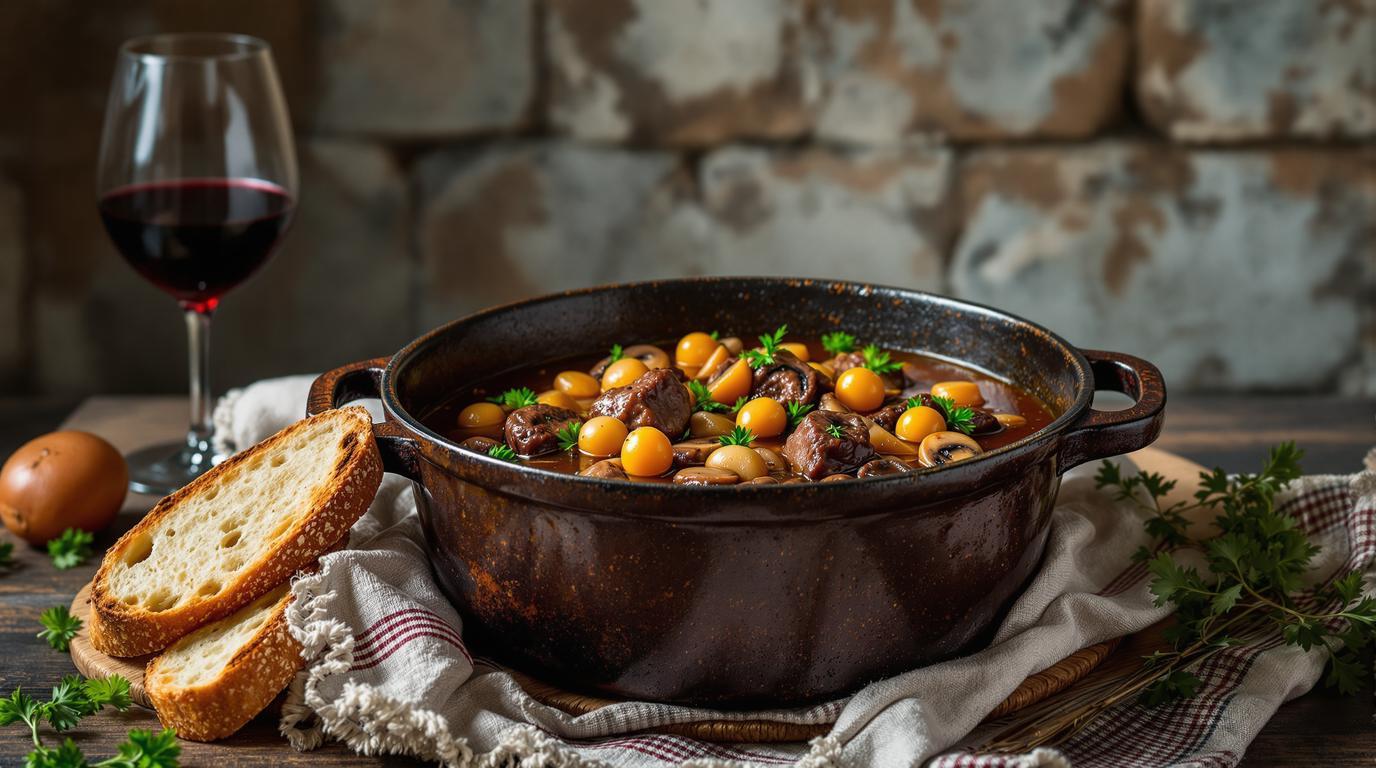The first time I made a proper French country beef stew was during my apprenticeship in Lyon. My mentor, Chef Bernard, insisted I master this dish before anything else. “This is the soul of French cooking,” he’d say, wiping his brow over steaming copper pots. What makes this rustic classic so special isn’t fancy techniques or exotic ingredients—it’s patience. Those tough, inexpensive cuts of beef transform into something miraculous after a long, wine-infused bath. This humble peasant dish has sustained generations of French families, turning simple ingredients into Sunday dinner magnificence.
The Soul of French Country Cooking 🇫🇷
True French country beef stew sits at the intersection of necessity and brilliance. Historically, village cooks used what they had—tough cuts of beef, local wine, and garden vegetables—transforming them through slow cooking into something extraordinary. While Hungarian goulash relies on paprika for its signature flavor, this French classic draws its depth from red wine and careful browning techniques.
What I love about this dish is how it changes character depending on the region. In Burgundy, you’ll find the classic version with pearl onions and mushrooms. Travel south to Provence, and olive oil replaces butter, with herbs like rosemary taking center stage. My version leans traditional but incorporates elements from both regions—the rich wine base of Burgundy with the rustic vegetable approach of country cooking.
Essential Ingredients & Preparation 🧾
For a proper French country beef stew that serves 6-8, you’ll need:
- 3 pounds (1.4 kg) beef chuck, cut into 1½-inch cubes
- 12 ounces (340g) thick-cut bacon or pancetta, diced
- 2 cups (475ml) full-bodied red wine (Burgundy or Pinot Noir)
- ½ cup (120ml) Cognac (optional but traditional)
- 1 pound (450g) pearl onions, peeled (frozen works perfectly fine)
- 1 pound (450g) button mushrooms, quartered
- 2 cups mixed root vegetables (carrots, potatoes, turnips)
- Bouquet garni (thyme sprigs, bay leaf, parsley stems tied together)
- 2 tablespoons tomato paste
- 4 cloves garlic, minced
- 2 cups (475ml) beef stock
- 2 tablespoons unsalted butter
- 2 tablespoons all-purpose flour (for thickening)
The Essential Technique 🔪
The magic of this stew happens in stages:
- Pat your beef cubes completely dry with paper towels and season generously with salt and pepper. This step is non-negotiable—moisture is the enemy of proper browning.
- In a heavy Dutch oven, crisp the bacon over medium heat until golden. Remove with a slotted spoon, leaving the fat behind.
- Brown the beef in batches (never crowd the pan!) until deeply caramelized on all sides. This isn’t just cooking—it’s creating flavor compounds that form the foundation of your stew.
- Reduce heat to medium-low. Add onions and garlic to the pot, stirring until fragrant.
- Add Cognac to deglaze (stand back—it may flame), scraping up all those precious browned bits from the bottom.
- Return beef and bacon to the pot. Add wine, stock, tomato paste, and bouquet garni. Bring to a gentle simmer.
- Transfer covered pot to a 325°F (160°C) oven for 2½ hours, until meat is fork-tender.
- During the final 45 minutes, add mushrooms, pearl onions, and root vegetables.
- For the finishing touch, mash butter and flour together into a paste (beurre manié) and whisk in to thicken the sauce.
Chef’s Note: The stew actually improves overnight. Make it a day ahead, refrigerate, then skim off solidified fat before gently reheating. The flavors will have married beautifully—this was my grandfather’s secret to serving the perfect stew at family gatherings.
Serving Suggestions & Pairings 🍷
Serve this robust stew in wide, shallow bowls that showcase the components. A rustic country bread is essential for mopping up the sauce—the French would consider leaving any behind a minor sin! For wine pairing, nothing complements the dish better than the same style used in cooking: a Burgundy Pinot Noir or Côtes du Rhône. These wines echo the flavors in the stew while cutting through the richness.
For sides, I recommend keeping it simple. A crisp green salad with a bright vinaigrette provides welcome contrast, similar to how a vibrant shakshuka balances rich, slow-cooked flavors with fresh accompaniments.
This hearty stew shares the same soul-satisfying quality as Nonna’s potato gnocchi—both transform humble ingredients into something extraordinary through practiced technique and patience. While Korean cuisine might bring explosive flavors through fermentation, and Roman flatbread showcases elegance in simplicity, this French stew derives its character from time-honored braising methods that haven’t changed for centuries.
Remember, the true beauty of French country cooking lies in its patience. This isn’t fast food—it’s slow food, developed over generations to extract maximum flavor from minimal ingredients. The time you invest will be rewarded tenfold in the depth and complexity of your finished dish. As we say in professional kitchens: rush the braise, waste the braise.
